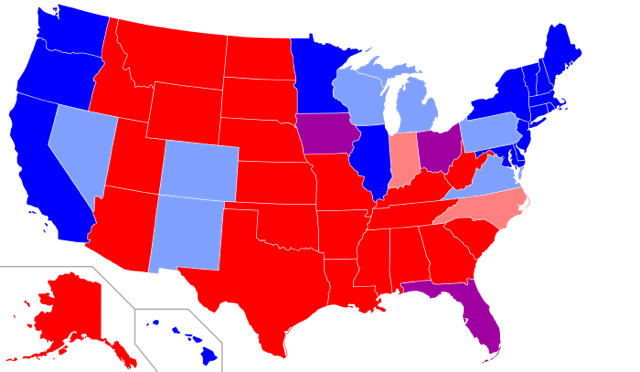Nancy Pelosi’s Impeachment Surge Strategy
Listen to audio version of this article

BY BERNIE KENNY
The problem for Democrats is not the popular vote in Presidential elections. Since 1992, Democrats have won six of seven popular votes for President, losing it only in 2004 (which was the 9/11 and Iraq War election). In 2000 and 2016, however, Republicans won the Presidency through the Electoral College.
Hillary Clinton had about 66 million votes in 2016, the same as Obama in 2012. However, Clinton had about 1 million more votes than Obama in California, meaning she got that much less in the rest of the country. This California “problem” tends to show up elsewhere for Democrats where they run the table in certain States but since 55 Electoral votes is 55 votes, it’s surplus popular votes.
Donald Trump got about 63 million votes, losing to Clinton by 3 million votes but all of that differential and more came out of California. Clinton lost the popular vote outside of California. Mitt Romney received around 61 million, losing to Obama by 5 million. Obama won outside of California by about 2 million.
When Democrats look at these numbers, it means the surest way to for them to “avoid” the consequence of another Electoral College (EC) defeat despite winning the popular vote is to grow turnout in the ten or so “swing” states.
Thus arises the question of 2020. Would an impeachment process – duly highlighting and politicizing the Russian interference in the 2016 election and the obstruction of justice and other crimes in connection with that election and its aftermath – enhance and drive the Democratic base vote, Democratic-leaning independent voters and younger whites on social issues (such as abortion, racism, climate, gun control)?
The Republican base vote is the white, non-Hispanic vote which is 63 % of the total vote of which Republican Presidential candidates in the last two elections are getting 59%. That’s around 37 % of the total vote ….a very significant, dependable base from which to operate. Trump and Romney each won the white vote by 20 points. Moreover it is dominant in a majority of States. The Democratic base vote is more concentrated creating the voter surplus referred to above, not helpful in the EC.
The Democratic base vote is white Dems (24%), African Americans(12%), Hispanic (11%), Asian (4%). More than enough to win if there’s a good turnout. The percentages of these subgroups is strongly Democratic but not uniformly so and a drop in these numbers is damaging to Democrats. Clinton in 2016 received 5% LESS of both African -American ( 88 vs 93) and Hispanic vote ( 66 vs 71 ) than Obama in 2012. Trump picked up a few points in each category. This and depressed Democratic enthusiasm was devastating in Michigan, Pennsylvania, and Wisconsin.
A strong turnout of the Democratic coalition means victory . Anything middling spells Electoral College. Less than middling is certain defeat.
So Democrats need there to be lines out the door from their core vote on November 3 , 2020. Does the Impeachment issue, strongly featured over the next 17 months , create the necessary surge in the Democratic base vote?
Speaker Pelosi is looking at this with green eyeshades with a keen awareness that the non-white vote is increasing every four years. It was 19% in 2000; 29% in 2016; and projected at 33% in 2020. An ignition of this vote, hardened in its disgust with Trump, will defeat the President and his reliance on the Electoral College to save him.
Bernie Kenny of Hoboken is the former Senator from the 33rd District.











Leave a Reply